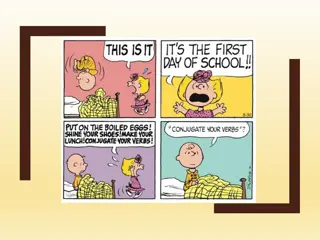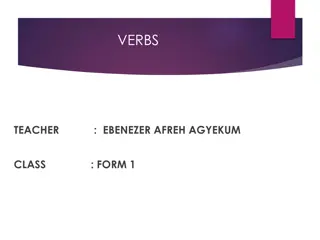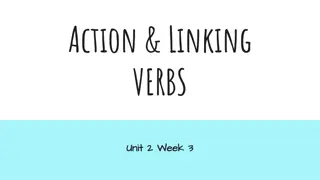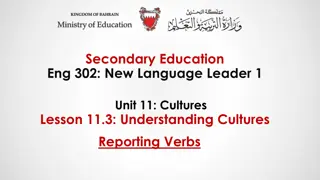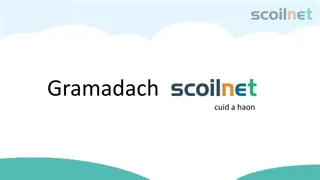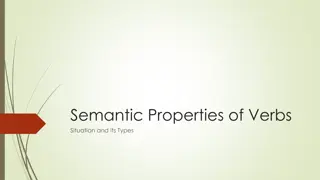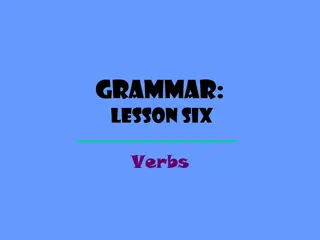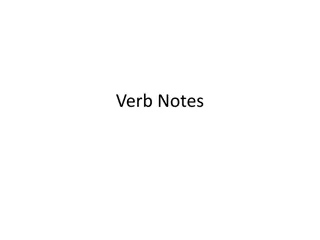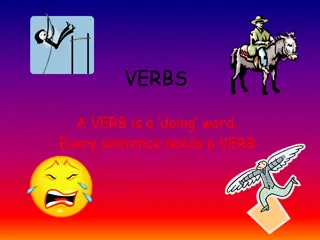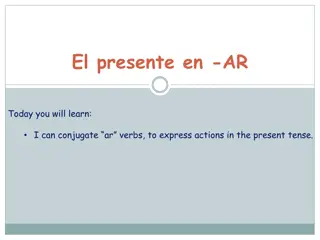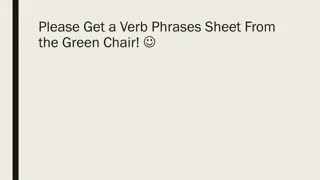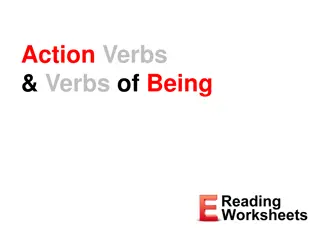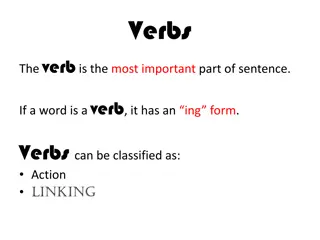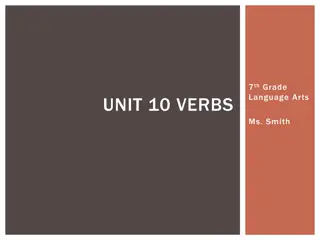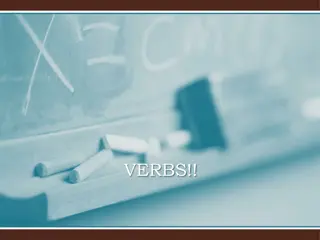Understanding Verbs: Action vs. State, Dynamic vs. Stative
Verbs are essential in sentences, describing actions or states of subjects. They can convey a sense of action like running or state like being. The distinction between dynamic (action) and stative (non-action) verbs is crucial, with dynamic verbs being used in continuous tenses and stative verbs describing states. Explore different types of verbs and their usage in this informative content.
Download Presentation

Please find below an Image/Link to download the presentation.
The content on the website is provided AS IS for your information and personal use only. It may not be sold, licensed, or shared on other websites without obtaining consent from the author. Download presentation by click this link. If you encounter any issues during the download, it is possible that the publisher has removed the file from their server.
E N D
Presentation Transcript
1 2 3 4 5 6 My son is a doctor. (linking/ copular verb) The student wrote intelligent essays. (transitive) He went home late. (intransitive) She gave me a flower. (double transitive) Please abide by the rules. (multi word verb) They elected him class representative. (verb of incomplete predication) 7 8 9 The put the book on the table. (verb of incomplete predication) The window broke. (ergative verb) You must avail yourself of the opportunity. (reflexive verb)
What are Verbs? The verb is a word that describes some action or state of the subject. The shortest sentence contains a verb. You cannot make a one-word sentence with any other type of word. However, you can make a one-word sentence with a verb, for example: Stop! Listen!
Verbs are sometimes described as "action words". This is partly true. Many verbs give the idea of action, of "doing" something. For example, words like run, fight, do and work all convey action. He is running. I work hard.
But some verbs do not give the idea of action; they give the idea of existence, of state, or of "being". For example, verbs like be, exist, seem and belong all convey state. i. ii. iii. I am a teacher. There are four books on the table. He became rich after doing business. A verb always has a subject. In the sentence like "Ahmed speaks English", Ahmed is the subject and speaks is the verb. In simple terms, therefore, we can say that verbs are words that tell us what a subject does or is; they describe action or state: Action: Hassan plays football. (action) State: Ahmed seems kind. (state)
Dynamic and Stative Verbs: The verbs that describe action are called "dynamic", and can be used with continuous tenses. Other verbs describe state (non-action, a situation). They are called "stative", and cannot normally be used with continuous tenses (though some of them can be used with continuous tenses with a change in meaning).
DYNAMIC VERBS Activity Verbs I am teaching you. I was learning French. They will be playing upstairs. Virtually identical in meaning to simple tense forms: I teach you. I learned French. They will play upstairs. abandon ask beg call drink Process Verbs The corn is growing rapidly. Traffic is slowing down. Virtually identical in meaning to simple present tense forms: The corn grows rapidly. Traffic slows down. change deteriorate mature eat help learn listen play rain read say throw whisper work write look at slice grow slow down widen
Verbs of Bodily Sensation I feel bad" and I am feeling bad are virtually identical in meaning. feel hurt Transitional Events Verbs Progressive forms indicate the beginning of an event, as opposed to the simple present tense. "She was falling out of bed [when I caught her]" as opposed to "She falls out of bed every night." leave fall land Momentary Verbs Progressive forms indicate little duration and suggest repetition. She is hitting her brother. He is jumping around the house. nod kick knock
STATIVE VERBS Verbs of Inert Perception and Cognition* I detest bad jokes, but not I am detesting bad jokes. I prefer toast, but not I am preferring toast. satisfy see smell suppose taste think understand want wish abhor adore astonish believe desire detest dislike doubt feel forgive guess hate hear imagine impress intend know like love mean mind perceive please prefer presuppose realize recall recognize regard remember
Relational Verbs I am sick, but not I am being sick. I own ten acres of land, but not I am owning ten acres. My brother owes me ten rupees" but not My brother is owing me ten rupees. depend on deserve equal fit have include involve lack matter need owe own possess require require resemble seem sound be* belong to concern consist of contain cost
Verb Classification Main Verbs: Main verbs are also called "lexical verbs". Main verbs have meaning on their own (unlike helping verbs). There are thousands of main verbs, and we can classify them in several ways. Ali works hard. (works is the main verb) Helping Verbs: Helping verbs have no meaning on their own. They are necessary for the grammatical structure of a sentence, but they do not tell us very much alone. We usually use helping verbs with main verb. They "help" the main verb (which has the real meaning). We divide them into two basic groups:
Primary Helping Verbs: These are the verbs be, do, and have. Note that we can use these three verbs as helping verbs or as main verbs. On this page we talk about them as helping verbs. We use them in the following cases: Be: to make continuous tenses (He is watching TV.) to make the passive (Small fish are eaten by big fish.) Have: to make perfect tenses (I have finished my homework.) Do: to make negatives (I do not like you.) to ask questions (Do you want some coffee?) to show emphasis (I do want you to pass your exam.)
Modal Helping Verbs: We use modal helping verbs to "modify" the meaning of the main verb in some way. A modal helping verb expresses necessity or possibility, and changes the main verb in that sense. These are the modal verbs: can, could may, might will, would, shall, should must ought to
Semi-Modal Verbs: The following verbs are often called "semi-modals" because they are partly like modal helping verbs and partly like main verbs: need ii. dare iii. used to
Classification of Verbs A Transitive Verb is a verb that denotes or describes an action which passes over from the doer or subject to an object or affects something or someone. Examples: The boy reads his book. (reads what? his book) The object is the noun or noun equivalent that receives the action of the verb. To find object in the sentence, put what or whom after the verb. The object is of a transitive verb is called a direct object. Some verb can only be used transitively. He made something. (NOT He made.) I like it. (NOT I like.) The car hit a tree. (NOT The car hit.) He brought the book. (NOT He brought.)
Intransitive Verb (Not Passing Over): (The verb that does not take an object) An Intransitive Verb is a verb that denotes or describes an action which does not pass over to an object. Examples: i. ii. but the boy himself). The baby sleeps. (Sleep what? no answer) The boy is running. (The action of running doesn t take place on anything else
Some verbs (e.g. walk, run, work, pass) can be used transitively and intransitively to express different meanings: Many verbs can be either transitive or intransitive, depending on the meaning and context: He likes to drink. He drank some juice. The children are playing. The children are playing football. Transitive Intransitive We walked to the park. Please let me pass. He walked the dog. He passed the examination.
Multi-Word Verbs: Multi-word verbs are made up of a verb, an adverb and a preposition. Because they end with a preposition, multi-word verbs always take a direct object. Also, the three words that combine to form multi-word verbs cannot be separated. I'm hoping to catch up on some sleep. I need a couple of days in the office to catch up with my paperwork. Come up with something to think of or to suggest a plan or idea, a solution to a problem, or an answer to a question
Definition: Linking verbs or copular verbs link a subject to a complement. Linking verbs MUST be followed by a complement in order to make the sentence complete. The complement can be a subject complement or an adverbial, and occurs in two sentence types which are of the Subject-Complement(SVC) Subject-Verb- Adverbial(SVA). Linking verb links or connects the subject with a noun, a pronoun, or an adjective in the predicate or some times an adverb. It is a special group of intransitive verbs that makes a statement not by expressing action but by indicating a state of being or a condition of the subject.
A Linking Verb cannot function together with its subject as a complete sentence. Examples: i. He is S V ii. The baby seems S V iii. They are S V We see that despite S+V the sentence is not complete. To complete the sense, we require a word (noun or adjective). Such a verb is also called a Verb of Incomplete Predication. Now see: (Examples) He is happy. They are happy. The baby seems happy.
The Verb BE: Some grammarians refer to the verb be as "the copula" since this is its main function in English. All the forms of be can be used as a linking verb. Be is the main verb of the sentence, rather than the auxiliary and is used in both SVC and SVA patterns. I am at the office between 9 and 5. This is a really good class. Those books were very expensive. The students have been exhausted since the midterm. Their wedding will be in early May.
Lists of the most common linking verbs: appear John appeared happy when the company promoted him. be The graduate students are in Classroom South, Room 106. feel She felt really happy with the new baby. lie The pieces lay scattered over the floor. look This person looks really tired. remain Everybody remained silent for a few minutes. seem This secretary seems (to be) very efficient. smell That perfume smelled so fresh. sound She sounded very surprised when she heard the news. stay Everybody stayed calm when the fire alarm went off. taste This grapefruit tastes very bitter.
Resulting Linking Verbs: become He became a successful business man. get She got upset with her students. grow The professor grew unhappy because the students were not listening well. fall My brother fell in love at the party. prove The new secretary proved (to be) very friendly. run The children ran wild. turn The milk turned sour.
Ditransitive Verb: A Ditransitive verb such as cause or give is one that can take a direct object and an indirect object at the same time: "That music gave me a headache." Some Verbs (e.g. give, promise, bring, buy, send, show, offer, tell, etc) take two objects, one as direct object and other as indirect object. Such Verbs are called Double Transitive Verbs. I promised him a pen. Indirect Object Direct Object
To find the indirect object in a sentence, ask to / for whom or to / for what. i. ii. Transitive verbs of Incomplete Predication (Fictative): They have bought a new car for the officer (bought for whom? Officer) I give it to him (gave to whom? To him) These are the verbs which take only direct object, but still require some word or words to make the sense of the sentence complete. For example; They made Ali . S V O Despite its S + V + O, the sense of the sentence is not complete. But now see it. They made Ali Prime Minister. S V O OC (object complement)
Ergative verb In English, most verbs can be used intransitively, but ordinarily this does not change the role of the subject; consider, for example, "He ate the soup" (transitive) And "He ate" (intransitive), where the only difference is that the latter does not specify what was eaten. By contrast, with an ergative verb the role of the subject changes; consider "it broke the window" (transitive) And "the window broke" (intransitive).
Causative Verbs: Causative verbs designate the action necessary to cause another action to happen. In "The devil made me do it." the verb "made" causes the "do" to happen. Most of them are followed by an object (noun or pronoun) followed by an infinitive: i. She allows her pet to perch on the windowsill. ii. She hired a carpenter to build a new birdcage." Three causative verbs are exceptions to the pattern described above. Instead of being followed by a noun/pronoun and an infinitive, the causative verbs have, make and let are followed by a noun/pronoun and the base form of the verb (which is actually an infinitive with the "to" left off). i. Professor Amera had her students read four short novels in one week. ii. She also made them read five plays in one week. iii. However, she let them skip the final assignment.
In this causative sentence the structure is following. Causative Subject Causative Verb Causative Object/ Verb main 3 form written everyday. The teacher gets the essay He gets/has a letter written. He is getting/having a letter written. He has got/had a letter written. He has been getting/having a letter written.
Reflexive verbs are verbs whose subjects are also their direct objectsthat is, the action of the verb is both committed and received by the same person or thing. Reflexive verbs are sometimes identified as being in the middle voice (as opposed to the active voice or passive voice. Identifying reflexive verbs Verbs with reflexive pronouns Reflexive verbs can most easily be identified by the use of reflexive pronoun, which are used as the direct object and refer back to the subject of the sentence. For example: I accidentally burned myself with the hairdryer. (Myself refers to the subject, I.) The baby is smiling at herself in the mirror. (Herself refers to the subject, the baby.) The problem seems to have worked itself out in the end. (Itself refers to the subject, the problem.)
A few of such verbs have survived to the present day: overeat; avail; avenge etc. He overate himself. He availed himself of the opportunity. She had decided to avenge herself.
Instructions for students Please read these slides and wherever you find some difficulty refer to the Verb chapter in the recommended book. Solve all the exercises given in the book and check their answers. If you have any question, please WhatsApp it.


